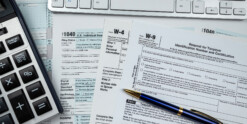I recently got a question from a listener to my radio show that I believe is relevant to just about every investor out there. For the sake of this article, we’ll call her Debbie.
Debbie is retired and in her early 60s. For years, she kept a significant portion of her retirement savings in cash, waiting to put it to work when the time was right. We all know that the current return on money market accounts is relatively paltry, so Debbie expressed some frustration. Because of this year’s volatility, she has seen some losses and wanted to know when would be a good time to make some changes. Is now the time to get more invested in the market by diversifying her assets into more aggressive holdings?
Here, it seems Debbie’s question is about diversification. But it’s not. This is a question about timing. In essence, she was asking if now is a good time to put more money in stocks.
This is always a delicate question to answer, because none of us know exactly what the future holds over the next week, month or even year. But what we do know is that participation is more important than perfection when trying to time the market. So, my advice always is to aim for participation (preferably long-term participation) over perfect timing.
Believe me — I know why folks ask about timing. We watch the market seesaw, and we want to ”buy low” and ”sell high.” In our recent economic climate, folks seem especially concerned about “getting in at the right time.”
Think about it. Over the course of the year, we’ve watched the market rally to record highs in January and then spend the next three months in and out of correction mode. Here we are almost to summer (it already feels like it outside), and markets are dancing around the flat line year-to-date, despite the tremendous volatility the market has endured in 2018.
The reasons for investors’ current unease are abundant. There’s the fear of rising interest rates from the Fed, which could make borrowing more expensive and lead to an economic slowdown. There’s lingering concern about a trade war with China that likely won’t be resolved until much later in the year. And there’s the good news of peak earnings, with the attendant worry that the extra boost tax reform gave corporations this year has made earnings top out, with only slower growth going forward.
I want to point out that Debbie’s question, or some variation of it, is the most common query I get about investing for retirement. Sometimes, folks ask how they should get started in the market. Other times, they ask whether they should wait for another correction. Or they wonder if they should be more aggressive or more conservative in the current climate. No matter how they’re couched, these questions boil down to, “Is it time yet? Is it time yet?”
The truth is, no one, and I repeat, no one knows for sure when the “best” time is to buy into the market.
Let’s talk history, for a moment.
The data below illustrate how an investment of $10,000 in the S&P 500 would grow over a particular period of time. Each period given reflects a time when we saw major stock market corrections. As it takes time to recover from any downturn, the data show what you would have as of 2016 if you had invested your $10,000 during each period.
The data give growth values for “perfect” market timing (meaning when the correction is at its bottom), the “worst” market timing (meaning right before the market dipped), and simply holding your money in cash or CDs.
Here’s how the numbers compare for the time periods of a 25-year long run, 17- and 15-year intermediate runs, and eight- and five-year short runs.
Long Run — 25 Years — Investing in 1990
The year 1990 saw a four-month bear market.
Investing at the “perfect” time (the bottom of the correction) shows growth to $113,000.
Investing at the “worst” time (right before the correction) shows growth to about $100,000.
Holding cash showed growth to $20,000.
Intermediate Run — 17 Years — Investing in 1998
In 1998, the market saw a 20 percent correction.
“Perfect” timing yielded growth to $29,000.
“Worst” timing yielded growth to $25,000.
Cash grew to $14,000.
Intermediate Run — 15 Years — Investing in 2000
Ah, the tech crash. We all remember it; indeed, it was massive — the S&P 500 went down 49 percent.
Getting in the market with “perfect” timing yielded growth to $30,000.
Getting in with the “worst” timing yielded growth to $18,000.
Cash grew to nearly $13,000.
Here, investing at the “worst” time still bested cash by 42 percent.
Short Run — Eight Years — Investing in 2008
The Great Recession/Financial Crisis market period is also fresh in our memories.
During this time, “perfect” timing yielded growth to $29,000.
The “worst” timing yielded growth to $16,000.
Cash was practically flat, as interest rates were near zero during this span.
Investing at the “worst” time beat cash by 54 percent.
Short Run — 5 Years — Investing in 2011
This time period again saw a near 20 percent correction.
“Perfect” time investing yielded growth to $18,000.
“Worst” time investing yielded growth to $16,500.
Again, cash was practically flat, garnering growth of a mere $13.
This time, the “worst” timing beat cash by 66 percent.
Understanding market history helps us reinforce our investment mantra: Participation, not perfection. In every single scenario outlined above, investing at the “worst” time bested holding cash by a long shot.
So, there we have it — the best answer to the question that’s been nagging you. Participation, and the discipline to do so, is a more practical strategy than trying to perfectly time the market. And we as investors would do well to shift our thinking from “timing” to “time.” We want to buckle in for the long haul, be it five years, 15 years or 50 years.
The original AJC article appears here.
DISCLOSURE
This information is provided to you as a resource for informational purposes only. It is being presented without consideration of the investment objectives, risk tolerance or financial circumstances of any specific investor and might not be suitable for all investors. Past performance is not indicative of future results. Investing involves risk including the possible loss of principal. This information is not intended to, and should not, form a primary basis for any investment decision that you may make. Always consult your own legal, tax or investment advisor before making any investment/tax/estate/financial planning considerations or decisions.













